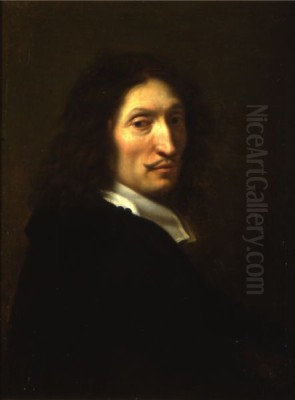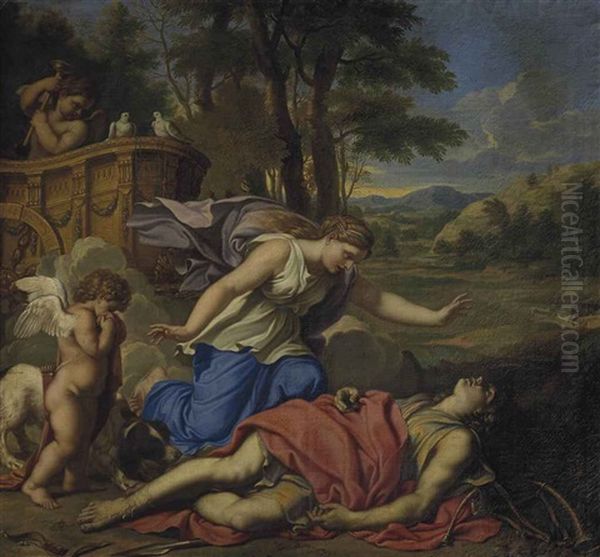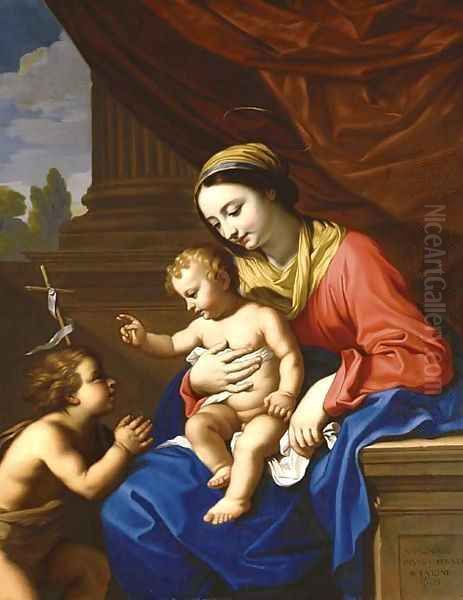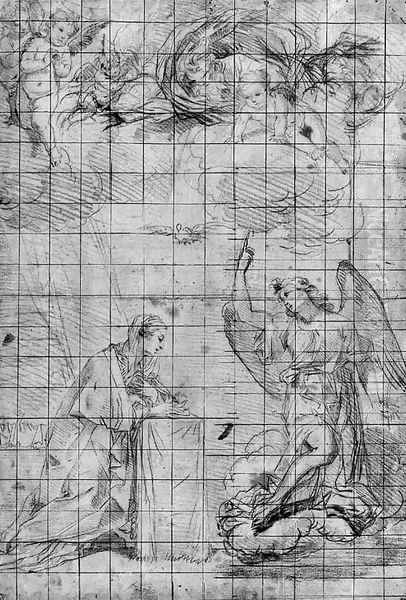
Nicolas Mignard, often referred to as Mignard d'Avignon to distinguish him from his more famous younger brother, Pierre Mignard ("le Romain"), was a significant French painter and engraver of the Baroque era. Born on June 4, 1606, in Troyes, and passing away in Paris in 1668, Nicolas Mignard carved out a distinguished career, particularly noted for his elegant portraits, compelling religious scenes, and decorative schemes. Though sometimes overshadowed by his sibling, his contributions to 17th-century French art are undeniable, reflecting both the pervasive influence of Italian classicism and the burgeoning grandeur of the French Baroque style under King Louis XIV.
Early Life and Artistic Formation in Troyes and Italy
Nicolas Mignard's artistic journey began in his native Troyes, a city with a rich artistic heritage. He received his initial training locally before venturing to Fontainebleau, a crucible of artistic innovation since the Renaissance, where artists like Rosso Fiorentino and Francesco Primaticcio had established a vibrant school of art. Seeking to further hone his skills, Mignard, like many aspiring artists of his time, undertook the customary voyage to Italy. He spent a crucial period in Rome, immersing himself in the masterpieces of the High Renaissance and the burgeoning Baroque movement.
In Rome, Mignard was profoundly influenced by the works of the Carracci family, particularly Annibale Carracci. He diligently studied and copied Annibale's compositions, absorbing the principles of classical idealism, balanced composition, and expressive figural representation that characterized the Bolognese school. Artists like Domenichino and Guido Reni, also key figures of this classical-Baroque synthesis, would have further shaped his artistic vision. This Roman sojourn was instrumental in refining his technique and solidifying his preference for a style that blended classical grace with Baroque dynamism. The impact of Caravaggio's dramatic naturalism, though perhaps less direct, was also part of the rich artistic tapestry of Rome that Mignard experienced.
The Avignon Period: "Mignard d'Avignon"

After his formative years in Italy, Nicolas Mignard did not immediately settle in Paris. Instead, he established himself in Avignon around 1637, a city with its own historical significance as a former papal seat and a vibrant cultural center. It was here that he truly came into his own, earning the moniker "Mignard d'Avignon." For over two decades, he became the leading painter in the region, undertaking numerous commissions for local dignitaries, religious institutions, and churches.
His work in Avignon included a wide range of subjects. He painted altarpieces and large-scale religious narratives that adorned churches and chapels, demonstrating his mastery of complex compositions and his ability to convey devotional sentiment. One notable example from this period is Frédéric Sforza Presenting Avignon to Saint Peter of Luxembourg (1641), a work that showcases his skill in portraiture within a historical-religious context, as well as his adept handling of color and light to create a dignified and compelling scene. His portraits from this era, such as the Portrait of Gabriel Teste (1658-1668), reveal a keen psychological insight and an ability to capture the sitter's status and personality with refined elegance.
During his time in Avignon, Mignard also produced engravings, further disseminating his compositions and contributing to his reputation. His style, characterized by a harmonious blend of Italianate classicism and French sensibility, found favor with the local clientele. He developed a reputation for his depictions of the Virgin and Child, often imbued with a tender grace that became a hallmark, sometimes referred to as "Mignardesque," a term also associated with his brother Pierre's similarly charming portrayals.
Return to Paris and Royal Patronage
In 1660, a significant turning point occurred in Nicolas Mignard's career. King Louis XIV, accompanied by his court, visited Avignon. The King, a discerning patron of the arts, was impressed by Mignard's talent. This royal encounter led to an invitation for Mignard to relocate to Paris, the epicenter of artistic and political power in France. Heeding the call, Mignard moved to the capital, where he would spend the remainder of his career.
In Paris, Nicolas Mignard's talents were quickly recognized. He received commissions for the royal residences, including decorative work for the Tuileries Palace and the Palace of Versailles. At Versailles, he was involved in decorating the King's smaller apartments (petits appartements du roi), contributing to the lavish artistic program overseen by figures like Charles Le Brun, the powerful First Painter to the King and director of the Gobelins Manufactory. While Le Brun dominated the grand decorative schemes, Mignard's contributions were valued for their elegance and refinement.

He was admitted to the prestigious Académie Royale de Peinture et de Sculpture (Royal Academy of Painting and Sculpture) in 1663, a testament to his standing in the Parisian art world. He later became a professor and eventually rector of the Academy, playing a role in shaping the artistic education of the next generation. His involvement with the Academy placed him at the heart of artistic discourse in France, an institution that sought to codify artistic principles and promote a distinctly French national style, often debating the merits of line (Poussinistes) versus color (Rubénistes).
Artistic Style, Themes, and Representative Works
Nicolas Mignard's artistic style is a compelling synthesis of Italian classical influences and French Baroque aesthetics. His grounding in the works of Annibale Carracci is evident in the clarity of his compositions, the idealized beauty of his figures, and his sophisticated use of color. However, his art also possesses a distinctly French elegance and a refined sensibility, avoiding the more overt drama found in some Italian Baroque masters.
His oeuvre encompassed a variety of genres. Portraiture was a significant aspect of his work. He depicted members of the aristocracy and prominent figures with a blend of formal dignity and psychological acuity. His portraits are characterized by careful attention to costume and attributes that signify the sitter's status, combined with a sensitive rendering of facial features and expression. The aforementioned Portrait of Gabriel Teste is a fine example of his skill in this genre.
Religious subjects formed another cornerstone of his output. He painted numerous altarpieces and devotional images, often depicting scenes from the life of Christ, the Virgin Mary, and the saints. These works, such as his "Mignardesque" Madonnas, are typically imbued with a gentle piety and a serene beauty. He also undertook large-scale religious decorations, including, according to some sources, work on the dome of the Val-de-Grâce church in Paris, a major Baroque commission, though his brother Pierre is more famously associated with its frescoes. He is also credited with frescoes in the dome of Notre-Dame in Paris.
Mythological and allegorical themes also featured in his repertoire, reflecting the classical tastes of the period. Works like Venus and Adonis and Perseus Slaying Medusa (from a series on the story of Ulysses/Odysseus) demonstrate his ability to handle complex narratives and dynamic figural arrangements, often with a rich, harmonious palette and a fluid brushwork. These paintings allowed him to explore the human form in various poses and to create dramatic, engaging scenes. His decorative paintings for royal and noble residences often drew upon such classical themes, contributing to the opulent interiors favored by the French elite.
The Mignard Brothers: A Tale of Two Artists

The artistic careers of Nicolas and Pierre Mignard are often discussed in tandem. Pierre Mignard (1612-1695), known as "Mignard le Romain" due to his extended and highly successful stay in Rome, achieved even greater fame than his older brother, eventually succeeding Charles Le Brun as First Painter to the King. While both brothers shared a common artistic grounding, influenced by their studies in Italy and their admiration for the classical tradition, their careers and specializations diverged to some extent.
Nicolas, as "Mignard d'Avignon," established a strong regional reputation before his later Parisian career. Pierre, on the other hand, built his formidable reputation primarily in Rome and then in Paris, becoming particularly renowned for his flattering and elegant portraits of the court, especially of women and children. His style was often seen as softer and more graceful, epitomizing the "Mignardesque" charm that appealed greatly to contemporary tastes.
There was undoubtedly a degree of professional interaction and perhaps even friendly rivalry between the brothers. They both navigated the competitive Parisian art world, which was dominated for a long period by the powerful Charles Le Brun. Pierre Mignard was a notable rival to Le Brun, and their stylistic differences and competition for royal favor were well-known. Nicolas, while also working for the court and active in the Academy, seems to have maintained a somewhat more independent path, though he too was part of the artistic establishment. Some accounts suggest Nicolas initially kept a distance from the Royal Academy when it was heavily under Le Brun's influence, possibly reflecting a family alignment or personal preference.
Despite Pierre's greater contemporary and historical fame, Nicolas's achievements were substantial. He was a respected master in his own right, contributing significantly to the artistic landscape of both Avignon and Paris. Their shared surname and artistic inclinations sometimes led to confusion in attributions, but modern scholarship has worked to delineate their individual contributions more clearly.
Nicolas Mignard and the Wider Artistic Milieu
Nicolas Mignard operated within a vibrant and transformative period in French art. The 17th century saw France emerge as a dominant cultural power in Europe, with Paris becoming a major artistic center. He was a contemporary of several key figures who shaped French Baroque and Classical art.

Simon Vouet (1590-1649) was an earlier figure who played a crucial role in introducing the Italian Baroque style to France upon his return from Italy. Mignard's generation built upon this foundation. Nicolas Poussin (1594-1665) and Claude Lorrain (1600-1682), though primarily based in Rome, exerted immense influence on French classicism with their idealized landscapes and historical paintings. Philippe de Champaigne (1602-1674) was another prominent contemporary, known for his austere and deeply spiritual portraits and religious works, often associated with Jansenism.
Eustache Le Sueur (1616-1655) and Laurent de La Hyre (1606-1656) were other important painters who contributed to the classical trend in French art. Sébastien Bourdon (1616-1671) was a versatile artist who worked in various genres and styles. The dominant figure for much of Mignard's Parisian career was, of course, Charles Le Brun (1619-1690), whose control over royal commissions and the Academy defined the official artistic taste of the era, often referred to as the Louis XIV style. Mignard's position within the Academy as a professor and rector indicates his respected status among these luminaries. He also had interactions beyond the visual arts; for instance, the famed playwright Molière (Jean-Baptiste Poquelin) reportedly commissioned a portrait from Nicolas Mignard, highlighting his connections within the broader cultural sphere.
Legacy and Reassessment
During his lifetime, Nicolas Mignard enjoyed considerable recognition, particularly in Avignon and later in Paris. He was a successful artist who received important commissions and held a respected position within the Royal Academy. However, in the historical narrative, his fame has often been eclipsed by that of his brother Pierre, and by other towering figures of the French Grand Siècle like Poussin and Le Brun.
A significant factor contributing to a period of relative obscurity was the French Revolution. Many of Mignard's works, particularly those in churches and aristocratic collections, were dispersed, destroyed, or lost during the revolutionary upheavals. This loss of a substantial portion of his oeuvre made a comprehensive assessment of his career more challenging for subsequent generations of art historians.
Nevertheless, in more recent times, there has been a renewed scholarly interest in Nicolas Mignard. Art historians have worked to reconstruct his catalogue, reattribute works, and better understand his specific contributions to 17th-century French art. Exhibitions and publications have helped to bring his art to a wider audience, allowing for a more nuanced appreciation of his talent.
His art is valued for its elegant synthesis of Italian classicism and French refinement. He successfully navigated the demands of various genres, from intimate portraits to grand religious and mythological compositions. While some critics, even in his time or shortly after, may have found his religious works occasionally lacking in the profound sublimity of a Poussin or the dramatic intensity of a Caravaggio, his paintings consistently display a high level of technical skill, a pleasing aesthetic, and a sensitive emotional intelligence.
Conclusion: An Enduring Figure in French Baroque Art
Nicolas Mignard stands as an important and accomplished artist of the French Baroque period. His journey from Troyes to the artistic centers of Italy and back to a distinguished career in Avignon and Paris reflects the path of many ambitious artists of his era. His ability to absorb and adapt Italian influences while retaining a distinctly French sensibility allowed him to create works of enduring appeal.
As "Mignard d'Avignon," he dominated the artistic scene of a major provincial center, and later, in Paris, he contributed to the artistic splendor of Louis XIV's court and played a role in the academic life of the capital. His portraits capture the dignity and character of his sitters, while his religious and mythological paintings demonstrate his skill in composition, color, and narrative. Though perhaps not as revolutionary as some of his contemporaries, Nicolas Mignard was a master craftsman and a refined artist whose work enriches our understanding of the diversity and quality of French art in the 17th century. His legacy, once partially obscured, continues to be rediscovered and appreciated for its elegance, skill, and historical significance.